
YEAR 11-12
VCE General Mathematics
Subject Area
Maths
VCE Units
1-4
About the Course
General Mathematics Units 1–4 provide for the study of non-calculus and discrete mathematics topics. They are designed to be widely accessible and provide preparation for general employment, business or further study, in particular where data analysis, recursion and financial modelling, networks and matrices are important. Students who have done only Mathematical Methods Units 1 and 2 will have had access to assumed key knowledge and key skills for General Mathematics Units 3 and 4 but may also need to undertake some supplementary study.
UNIT 1
Area of Study 1: Data analysis, probability and statistics
In this area of study students cover types of data, display and description of the distribution of data, summary statistics for centre and spread, and the comparison of sets of data.
Area of Study 2: Algebra, number and structure
In this area of study students cover the concept of a sequence and its representation by rule, table and graph, arithmetic or geometric sequences as examples of sequences generated by first-order linear recurrence relations, and simple financial and other applications of these sequences.
Area of Study 3: Functions, relations and graphs
In this area of study students cover linear function and relations, their graphs, modelling with linear functions, solving linear equations and simultaneous linear equations, line segment and step graphs and their applications.
Area of Study 4: Discrete mathematics
In this area of study students cover the concept of matrices and matrix operations to model and solve a range of practical problems, including population growth and decay.
UNIT 2
Area of Study 1: Data analysis, probability and statistics
In this area of study students cover association between two numerical variables, scatterplots, and lines of good fit by eye and their interpretation.
Area of Study 2: Algebra, number and structure
In this area of study students cover the use of graphs and networks to model and solve a range of practical problems, including connectedness, shortest path and minimum spanning trees.
Area of Study 3: Functions, relations and graphs
In this area of study students cover direct and inverse variation, transformations to linearity and modelling of some non-linear data.
Area of Study 4: Discrete mathematics
In this area of study students cover units of measurement, accuracy, computations with formulas for different measures, similarity and scale in two and three dimensions, and their practical applications involving simple and composite shapes and objects, trigonometry, problems involving navigation and Pythagoras’ theorem and their applications in the plane.
UNIT 3
Area of Study 1: Data analysis, probability and statistics
Students cover data types, representation and distribution of data, location, spread, association, correlation and causation, response and explanatory variables, linear regression, data transformation and goodness of fit, times series, seasonality, smoothing and prediction.
Area of Study 2: Discrete mathematics
Students cover the use of first-order linear recurrence relations and the time value of money (TVM) to model and analyse a range of financial situations, and using technology to solve related problems involving interest, appreciation and depreciation, loans, annuities and perpetuities.
UNIT 4
Area of Study 1: Data analysis, probability and statistics
Students cover data types, representation and distribution of data, location, spread, association, correlation and causation, response and explanatory variables, linear regression, data transformation and goodness of fit, times series, seasonality, smoothing and prediction.
Area of Study 2: Discrete mathematics
Students cover the use of first-order linear recurrence relations and the time value of money (TVM) to model and analyse a range of financial situations, and using technology to solve related problems involving interest, appreciation and depreciation, loans, annuities and perpetuities.
